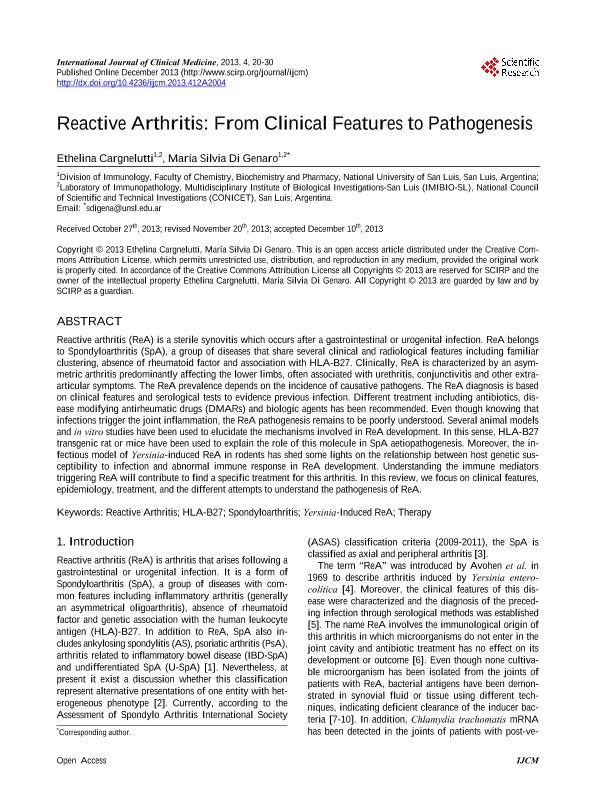Artículo
Reactive Arthritis: From Clinical Features to Pathogenesis
Fecha de publicación:
12/2013
Editorial:
Scientific Research
Revista:
International Journal of Clinical Medicine
ISSN:
2158-2882
Idioma:
Inglés
Tipo de recurso:
Artículo publicado
Clasificación temática:
Resumen
Reactive arthritis (ReA) is a sterile synovitis which occurs after a gastrointestinal or urogenital infection. ReA belongs to pondyloarthritis (SpA), a group of diseases that share several clinical and radiological features including familiar clustering, absence of rheumatoid factor and association with HLA-B27. Clinically, ReA is characterized by an asymmetric arthritis predominantly affecting the lower limbs, often associated with urethritis, conjunctivitis and other extraarticular symptoms. The ReA prevalence depends on the incidence of causative pathogens. The ReA diagnosis is based on clinical features and serological tests to evidence previous infection. Different treatment including antibiotics, disease modifying antirheumatic drugs (DMARs) and biologic agents has been recommended. Even though knowing that infections trigger the joint inflammation, the ReA pathogenesis remains to be poorly understood. Several animal models and in vitro studies have been used to elucidate the mechanisms involved in ReA development. In this sense, HLA-B27 transgenic rat or mice have been used to explain the role of this molecule in SpA aetiopathogenesis. Moreover, the infectious model of Yersinia-induced ReA in rodents has shed some lights on the relationship between host genetic susceptibility to infection and abnormal immune response in ReA development. Understanding the immune mediators triggering ReA will contribute to find a specific treatment for this arthritis. In this review, we focus on clinical features, epidemiology, treatment, and the different attempts to understand the pathogenesis of ReA.
Palabras clave:
Reactive Arthritis
,
Hla-B27
,
Spondyloarthritis
,
Yersinia-Induced Arthritis
Archivos asociados
Licencia
Identificadores
Colecciones
Articulos(CCT - SAN LUIS)
Articulos de CTRO.CIENTIFICO TECNOL.CONICET - SAN LUIS
Articulos de CTRO.CIENTIFICO TECNOL.CONICET - SAN LUIS
Articulos(IMIBIO-SL)
Articulos de INST. MULTIDICIPLINARIO DE INV. BIO. DE SAN LUIS
Articulos de INST. MULTIDICIPLINARIO DE INV. BIO. DE SAN LUIS
Citación
Di Genaro, Maria Silvia; Cargnelutti, Ethelina; Reactive Arthritis: From Clinical Features to Pathogenesis; Scientific Research; International Journal of Clinical Medicine; 4; 12B; 12-2013; 20-30
Compartir
Altmétricas




